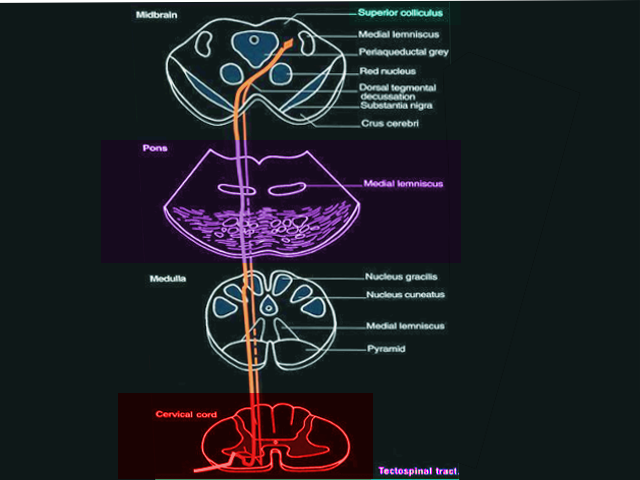[1]
Shinoda Y, Sugiuchi Y, Izawa Y, Hata Y. Long descending motor tract axons and their control of neck and axial muscles. Progress in brain research. 2006:151():527-63
[PubMed PMID: 16221600]
[2]
Nonnekes J, Carpenter MG, Inglis JT, Duysens J, Weerdesteyn V. What startles tell us about control of posture and gait. Neuroscience and biobehavioral reviews. 2015 Jun:53():131-8. doi: 10.1016/j.neubiorev.2015.04.002. Epub 2015 Apr 13
[PubMed PMID: 25882206]
[3]
Muto N, Kakei S, Shinoda Y. Morphology of single axons of tectospinal neurons in the upper cervical spinal cord. The Journal of comparative neurology. 1996 Aug 12:372(1):9-26
[PubMed PMID: 8841918]
Level 2 (mid-level) evidence
[4]
Amano E, Komatuzaki T, Ishido H, Ishihara T, Otsu S, Yamada I, Machida A. Pitfalls in the diagnosis of pupil-sparing oculomotor nerve palsy without limb ataxia: A case report of a variant of Claude's syndrome and neuroanatomical analysis using diffusion-tensor imaging. Journal of clinical neuroscience : official journal of the Neurosurgical Society of Australasia. 2018 Jan:47():120-123. doi: 10.1016/j.jocn.2017.09.027. Epub 2017 Oct 21
[PubMed PMID: 29066240]
Level 3 (low-level) evidence
[5]
Fregosi M, Contestabile A, Badoud S, Borgognon S, Cottet J, Brunet JF, Bloch J, Schwab ME, Rouiller EM. Corticotectal Projections From the Premotor or Primary Motor Cortex After Cortical Lesion or Parkinsonian Symptoms in Adult Macaque Monkeys: A Pilot Tracing Study. Frontiers in neuroanatomy. 2019:13():50. doi: 10.3389/fnana.2019.00050. Epub 2019 May 22
[PubMed PMID: 31191260]
Level 3 (low-level) evidence
[6]
Yamamoto N, Nakayama T, Hagio H. Descending pathways to the spinal cord in teleosts in comparison with mammals, with special attention to rubrospinal pathways. Development, growth & differentiation. 2017 May:59(4):188-193. doi: 10.1111/dgd.12355. Epub 2017 May 16
[PubMed PMID: 28509386]
[7]
Omi M, Nakamura H. Engrailed and tectum development. Development, growth & differentiation. 2015 Feb:57(2):135-45. doi: 10.1111/dgd.12197. Epub 2015 Feb 25
[PubMed PMID: 25716935]
[8]
Liu A, Joyner AL. EN and GBX2 play essential roles downstream of FGF8 in patterning the mouse mid/hindbrain region. Development (Cambridge, England). 2001 Jan:128(2):181-91
[PubMed PMID: 11124114]
[9]
Kiziltan ME, Gunduz A, Apaydın H, Ertan S, Kiziltan G. Auditory startle reflex and startle reflex to somatosensory inputs in generalized dystonia. Clinical neurophysiology : official journal of the International Federation of Clinical Neurophysiology. 2015 Sep:126(9):1740-5. doi: 10.1016/j.clinph.2014.11.004. Epub 2014 Nov 15
[PubMed PMID: 25534494]
[10]
Zanin J, Dhollander T, Farquharson S, Rance G, Connelly A, Nayagam BA. Review: Using diffusion-weighted magnetic resonance imaging techniques to explore the microstructure and connectivity of subcortical white matter tracts in the human auditory system. Hearing research. 2019 Jun:377():1-11. doi: 10.1016/j.heares.2019.02.014. Epub 2019 Mar 2
[PubMed PMID: 30877899]
[11]
Gates P. The rule of 4 of the brainstem: a simplified method for understanding brainstem anatomy and brainstem vascular syndromes for the non-neurologist. Internal medicine journal. 2005 Apr:35(4):263-6
[PubMed PMID: 15836511]
Level 3 (low-level) evidence
[12]
Bateman JR, Murty P, Forbes M, Collier KY, Tememe D, Marchena Od, Powers WJ. Pupil-sparing third nerve palsies and hemiataxia: Claude's and reverse Claude's syndrome. Journal of clinical neuroscience : official journal of the Neurosurgical Society of Australasia. 2016 Jun:28():178-80. doi: 10.1016/j.jocn.2015.12.010. Epub 2016 Feb 13
[PubMed PMID: 26883351]
[13]
Mc Govern EM, Killian O, Narasimham S, Quinlivan B, Butler JB, Beck R, Beiser I, Williams LW, Killeen RP, Farrell M, O'Riordan S, Reilly RB, Hutchinson M. Disrupted superior collicular activity may reveal cervical dystonia disease pathomechanisms. Scientific reports. 2017 Dec 1:7(1):16753. doi: 10.1038/s41598-017-17074-x. Epub 2017 Dec 1
[PubMed PMID: 29196716]

